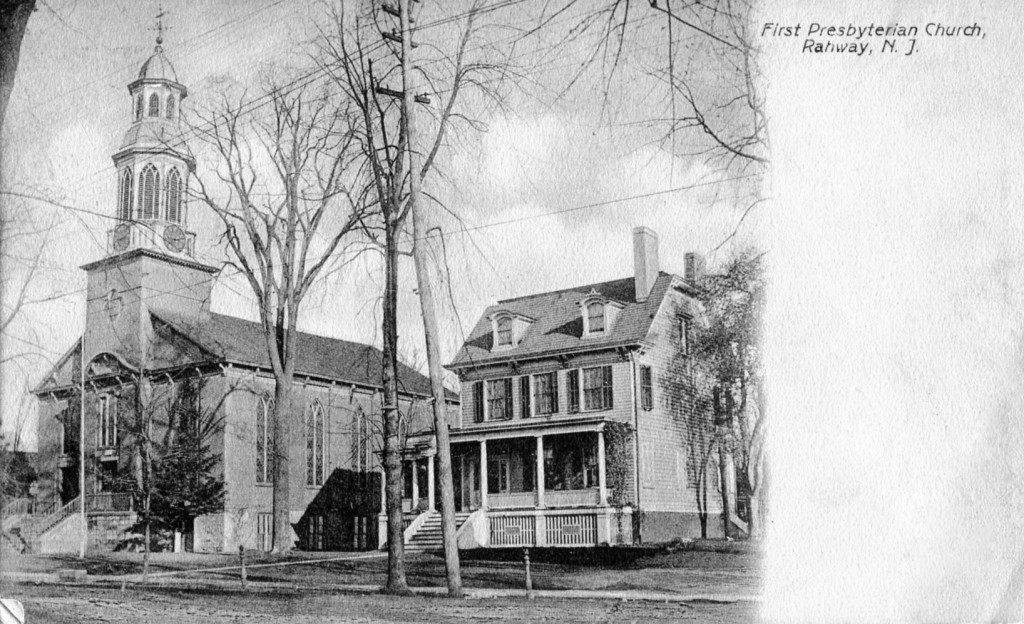By Al Shipley, City Historian and Rahway Library Research Consultant
This year, the First Presbyterian Church is celebrating 275 years of Christian ministry in Rahway. Founded in 1741, First Pres. has the longest tenure of any institution in the history of the city.
The four settlements of Rahway, Leesville (also called Lower Rahway), Bridgetown, Upper Rahway, and Milton, developed shortly after the founding of Elizabethtown and Woodbridge both of which date back to the 1660s. For the next seven decades, the inhabitants of the Rahway area had to travel to the two larger communities to conduct business or to participate in religious services. For religious groups, making the long trek to either city every Sunday was difficult at best, but during the winter of 1741, a time referred to as the “Hard Winter,” it became impossible. It was during that season that the Rahway Presbyterians made a formal request to organize their own church.
The construction of a sanctuary commenced in the summer of 1741 and was completed within the next year. It was built on St. Georges Avenue across from Union Street on the present grounds of the Rahway Cemetery. The location of the structure is clearly outlined by the position of the grave stones which stood on the north, south, and west sides of the church. This first church was two stories high and constructed of heavy timbers. A bell tower rose from the roof and was topped with a copper weathercock. During the Revolutionary War, the weather vane was damaged when a musket ball was shot through it. Church rolls listed members who were New Englanders, Scottish Presbyterians, those of Irish and Welsh extraction, Puritans, Covenanters, and Quakers.
For the first six years, sermons were given by visiting preachers. In 1748, Aaron Richards became the spiritual leader and remained in that position for the next forty-three years. His length of service is still the longest in the church’s history. In the mid-1770s, the Revolutionary War began bringing with it hardships and loss of life to the church. As a group, the Presbyterians were hostile towards the British who considered a Presbyterian and a rebel to be one and the same. Pastor Richards, an ardent patriot, was forced to flee to South Hanover to escape capture and imprisonment. While there, he continued to speak out against English rule and returned to Rahway only after his safety was no longer jeopardized.
A famous patriot, who was a member of the church, was Abraham Clark, a signer of the Declaration of Independence. A large granite monument marks his grave in the church cemetery.
In the years following the war, membership in the church increased and by 1830 it became apparent that a new and larger sanctuary was needed. A seventeen acre lot that encompassed the area from the corner of Grand Avenue and Church Street all the way back to the river had been left to the congregation by Pastor Richards. Ground was broken for a new church in May 1831. Job Squier and Samuel Oliver each gave $5,000.00 to help defray the $14,600.00 construction cost. The church, which was patterned after the Third Church in Newark, and minister’s home, which was built next to the church, were both dedicated on February 5, 1832.
As all parts of the city continued to grow, neighborhoods became populated enough to be able to support their own churches. By the 1840s, members of First Pres. who lived in Lower Rahway began to consider organizing a congregation that would be located closer to their homes. Discussions were held and on November 9, 1849 the way was made clear “with deep brotherly regard, cooperation, fellowship, and true Christian spirit” to organize the Second Presbyterian Church in Lower Rahway.
From the mid-19th century, the history of First Pres. continued to illustrate a congregation whose enthusiasm never waned and whose mission always encouraged improvement and refinement. In 1912, Mrs. William Squier donated a $6,000 organ to replace the old water-powered organ the church had been using since 1875. The congregation paid tribute to Mrs. Squier on December 6, 1926, when a new Community House, built behind the church, was dedicated to her memory. A new residence for the minister was built on Union Street and was dedicated on January 1, 1938. In 1967, many changes and modernization work took place. Improvements were made to the Community House, extensive renovations were made in the church sanctuary, and a new building, Davis Fellowship Hall, was added to the property. This large addition was named in honor of the Reverend Chester M. Davis, who served faithfully for thirty-six years (1922-1958).
The church was recognized as a historic site in 1974 by the Historical Sites Commission of the Presbyterian Historical Society. On January 29, 2012, after 160 years of faithful ministry, the congregation of Second Pres. reunited with the mother church marking a “New Dawn” in the history of Presbyterianism in Rahway. In 2016, the year of its 275 anniversary, First Pres. is a welcoming church that is actively engaged in creating a multi-cultural and multi-racial community of faith, striving to be a living testimony of Christ in the world.

